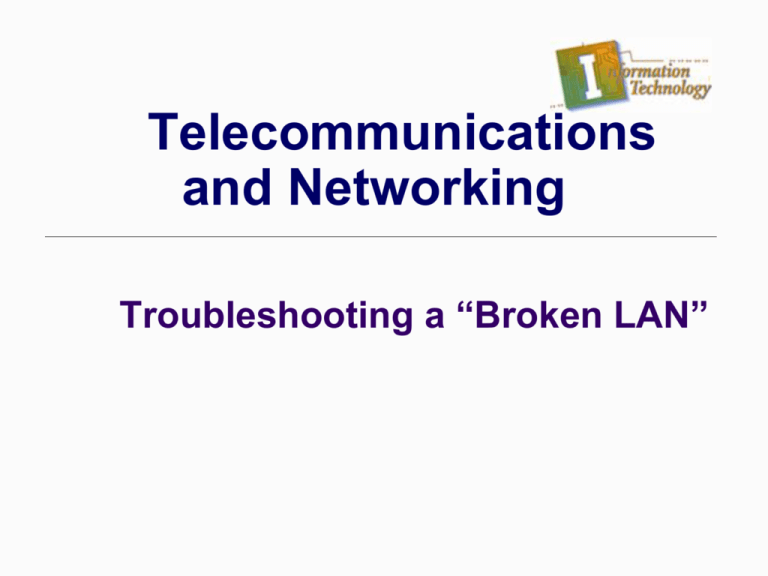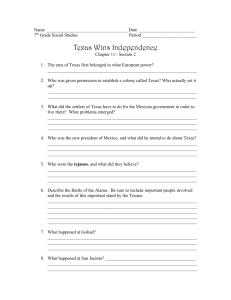
Telecommunications
and Networking
Troubleshooting a “Broken LAN”
Networking Basic Diagram
Copyright © Texas Education Agency, 2013. All rights reserved.
IP Address
Decimal
Number
Range
32 Bit Dotted Decimal Number:
0-255.0-255.0-255.0-255
Octet
Binary
Equivalent
(Either 0 or 1)
Octet
Octet Octet
00000000.00000000.00000000.00000000
Copyright © Texas Education Agency, 2013. All rights reserved.
Network ID
RED- Bits associated with the Network ID, must remain
intact for routing through the Internet
Black- Bits associated with individual hosts on the network.
These bits can be used to assign host addresses on the
network
Class A Address
11111111.00000000.00000000.00000000
Class B Address
11111111.11111111.00000000.00000000
Class C Address
11111111.11111111.11111111.00000000
Copyright © Texas Education Agency, 2013. All rights reserved.
Basic Networking Terms
Straight-Through Cable- An Ethernet cable used in networks which connect unlike devices (ex.PC to Switch, PC to Hub)
Cross Connect Cable- An Ethernet cable used in networks which connect like devices (ex. – PC
to PC, Hub to Hub)
Console Cable- An Ethernet cable used in networks which connect a PC to a console port of a
router or switch and allows configuration to take place.
Router- A network device which routs IP packets through the Internet based on the network IP
address.
Switch- A network device which routs network frames to their specific MAC destination address.
NIC (Network Internet Card)- An adapter card which, when inserted into a computer or laptop,
allows an Internet connection to that device.
Packet- A packet is a unit of information which is routed through the Internet by routers.
Frame- A frame is a container of data within a packet which is reviewed and sorted to individual
hosts on a network by a switch.
Peer to Peer Network- The simplest form of a network where a host is acting as both client and
server on the network.
Client-Server Network- A network where there is a central control of all network services (server)
to network hosts (clients).
Copyright © Texas Education Agency, 2013. All rights reserved.
Lab Diagram
Set up the following equipment for each of the
groups:
Router
Straight- Thru Cable
Switch
Straight- Thru Cable
Hub
(3) Straight- Thru Cables
(3) CPU’s- with Operating
Systems, Working NIC’s
Copyright © Texas Education Agency, 2013. All rights reserved.
Instructions
Configure all equipment with IP addresses
including:
Router:
Gateway
Network ID/ Subnet Mask
CPU’s:
IP Address/Subnet Mask
Default Gateway
TCP/IP Protocol Suite
Copyright © Texas Education Agency, 2013. All rights reserved.
Instructions- Cont.
Connect all cables
Check system by use of “ping” to:
All other CPU’s
Default Gateway
After ensuring correct functions, create errors in the network by
doing any or all of the following:
Change IP addresses of a CPU or Default Gateway to be non
compatible with rest of network
Use incorrect or damaged cable for any of the connections
Change Subnet Mask or Network ID in router
Copyright © Texas Education Agency, 2013. All rights reserved.
Instructions- Cont.
Allow students to investigate the LAN in order to
find out possible errors in the network
Students should then repair the problem
Students should then document the entire
process on a Lab Report Form
Copyright © Texas Education Agency, 2013. All rights reserved.








